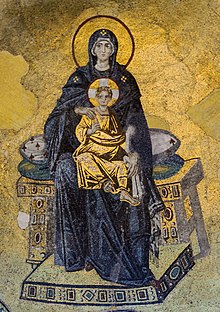
Back فن مقدس Arabic فن دينى ARZ Arte sacro AST ধর্মীয় শিল্পকলা Bengali/Bangla Art sacre Catalan Církevní umění Czech Religiøs kunst Danish Religia arto Esperanto Arte sacro Spanish هنر دینی Persian
This article needs additional citations for verification. (October 2010) |

Religious art is a visual representation of religious ideologies and their relationship with humans. Sacred art directly relates to religious art in the sense that its purpose is for worship and religious practices. According to one set of definitions, artworks that are inspired by religion but are not considered traditionally sacred remain under the umbrella term of religious art, but not sacred art.[1]
Other terms often used for art of various religions are cult image, usually for the main image in a place of worship, icon in its more general sense (not restricted to Eastern Orthodox images), and "devotional image" usually meaning a smaller image for private prayer or worship. Images can often be divided into "iconic images", just showing one or more figures, and "narrative images" showing moments from an episode or story involving sacred figures.
The use of images has been controversial in many religions. The term for such opposition is aniconism, with iconoclasm being the deliberate destruction of images by people of the same religion.
© MMXXIII Rich X Search. We shall prevail. All rights reserved. Rich X Search